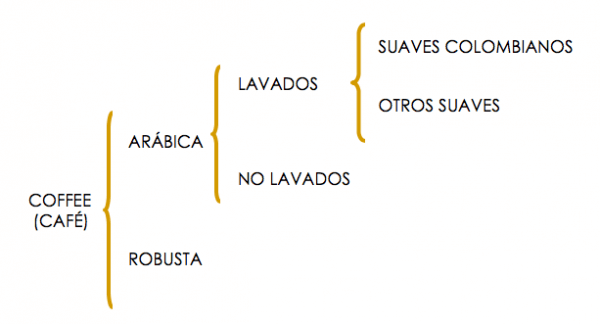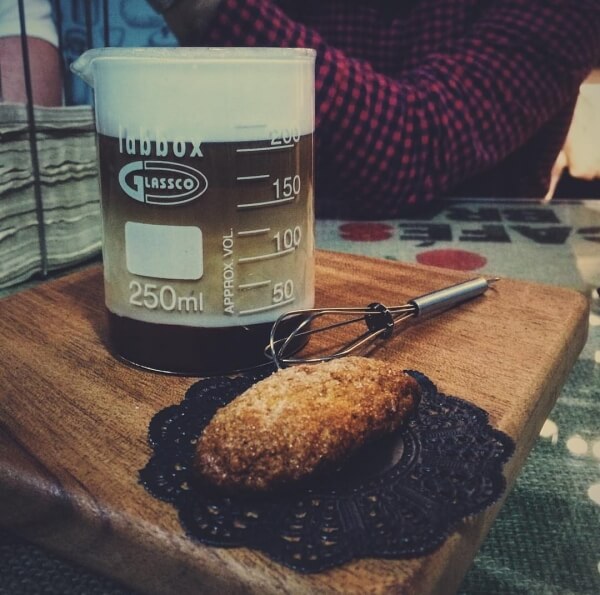Clasificación mundial del café

Café de especialidad 100% Arábica de CafeLab.
En el comercio internacional, la O.I.C. (Organización Internacional del Café) -organismo que reúne a los principales países productores, -que han cambiado mucho con respecto a los del origen del café– ha establecido la siguiente clasificación mundial:
Organización mundial del café

Clasificación mundial del café.
La planta del café, “cafeto”, pertenece a la familia de las rubiáceas, y al género “coffea”. Este comprende unas setenta especies, de las cuales en la actualidad dos son las más importantes en la producción comercial del café.
El fruto del café se denomina baya o cereza, porque tiene la misma forma, tamaño y color que esta. Debajo de la piel brillante de tono rojizo está la pulpa, sustancia amarillenta dulce que rodea a los granos de café, que son las semillas. Normalmente hay dos granos por baya enfrentados por su cara plana. Cada grano está encajado en una funda protectora de color crema y con forma de alubia llamada pergamino, que mantiene el grano separado de la pulpa.
Café Arábica
Originario de Etiopía, es la variedad más antigua, extendida y apreciada por su excelente calidad. Su cultivo es más delicado y requiere mayores cuidados, ya que es más susceptible a las enfermedades, plagas y heladas. Representa casi el 70% de la producción mundial.
Su floración se produce al tercer año de la plantación. En condiciones normales, seis años después de la primera floración la planta se encuentra en pleno rendimiento. Cinco kilos de fruto, una vez procesados, representan aproximadamente un kilo de café. Los mejores granos se cosechan en alturas superiores a los 1.500 metros de altitud, requieren temperaturas de entre 15 y 25 grados, iluminación abundante, vientos moderados y lluvias frecuentes.
Los arbustos de Arábica florecen después de la temporada de lluvias, después deben transcurrir aún nueve meses para que el fruto madure. Sus frutos son ligeramente elípticos, suaves, levemente agrios, de color verde oliva, de corteza lisa e intenso perfume.

¿Has probado nuestro café de especialidad?
Café Robusta

Desayuno café Mundial CafeLab.
Originario de Zaire, su interés económico es muy grande porque puede cultivarse en terrenos bajos. Su cultivo no es tan delicado como ocurre en el caso del Arábica porque es una planta más precoz, resistente y productiva, soporta mejor las variaciones de temperatura y necesita menos altitud para su desarrollo -alrededor de unos 500 metros-. Representa el 30% del total de la producción mundial.
Su floración se produce al segundo año de la plantación y la primera recolección, como en el Arábica, se produce al siguiente año, pero no es hasta el sexto cuando se obtiene un rendimiento normal. Sus frutos son redondeados, amargos, fuertes, de mayor contenido en cafeína, color marrón claro, corteza lisa y poco aromáticos, por lo que resulta más áspero en la taza.
Por otro lado, los cafés Lavados deben su nombre, no al tipo de café, sino al tratamiento al que son sometidas sus cerezas:
Los cafés Lavados son aquellos cuyas cerezas son tratadas por “Vía Húmeda”. Tradicionalmente la mayoría de los cafés tratados por este sistema eran de la variedad Arábica.
Los cafés No Lavados son aquellos que son tratados por “Vía Seca”. También tradicionalmente la mayoría de los cafés tratados por este sistema eran de la variedad Robusta. Aunque actualmente, gracias a los cafés de especialidad, la producción del café ha evolucionado mucho y ya podemos encontrar Arábicas No Lavados y Robustas Lavados.
Se conocen como Suaves Colombianos, cafés Arábicas y Lavados. Estos se producen principalmente en Colombia, Kenia y Tanzania, ya que las características climáticas de estos países permiten ofrecer cosechas muy homogéneas.
Otros Suaves. Se trata también de cafés Arábicas Lavados, aunque producidos principalmente en Centroamérica. En países tales como Costa Rica, Guatemala y Méjico, entre otros.